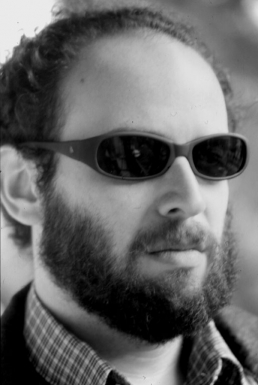What is the typical movement of electronic image? The television tube transforms the small points into moving images. Differently from the photochemical cinematic image, electronic image is almost a pulsation, an eruption of signs which from an image open to any kind of manipulation or incorporation of noises.
Manolo Arriola knows very well the implications of electronic image, and, in spite of the formal rigour of his work, he uses the very structural logic of video in some of his videos, as in Paseo Catódico (1999). In this video, the walking of a man within the limited space of the screen deals with the specificities of the movement of video image and the forms of perception that are generated by video image. The effect produced by digital zoom, which extends the image almost to the point of distortion, combined with extracts from Ernst Gombrich's texts and with the almost exhaustive repetition of the image, highlights this search for a certain specificity of electronic image and its movements.
Arriola's works deal with the relation between movement and perception by means of the typical resources of video like video stills, repetition, and the dilution of image under overlayings and incorporation of noises. In Malgré-tout (2001), a video inspired by a homonymous sculpture by Mexican artist Jésus F. Contreras (1866-1902), Arriola mixes the movements of the image with the movements created during the editing process. The result is almost a palimpsest of images, noises, shadows, and figures. The images, open to manipulation and the rigour of formal composition, come and go in a cosntant flux, a typical characteristic of video art. This video was produced with funding from the National Fund for Culture and the Arts, CONACULTA-FONCA (2000-2001).
If some of works can be viewed as meta-videos, other video works by Arriola deal with the processes of signification generated by the movements. In King (1999), Arriola builds an association between the sculptures of Elvis Presley and Jesus Christ, showing how icons, idols, and images are created and put in circulation in current society.
Arriola searches the visibility of movement through vertiginous images, highlighting their repetition almost loop in loop, as in Flicker (2000) and Mismo (2001). The former finds in the images of the film La Tormenta, by Fernando Vallejo, the material for the re-creation of movement; the latter reconstructs the meanings and perception of the movements of a man who is doing physical exercises through the overlaying and repetition of the same images.
In this eight edition of the FF>Dossier, we feature some of Manolo Arriola's works, deepening our investigation of the artists of the Southern Circuit. The contribution of Priamo Lozada, curator of Laboratório Arte Alameda, a cultural centre dedicated to promoting, producing and encouraging contemporary art practices in Mexico City, and Pilar Villela, who has written an essay on Arriola's work, has been of vital importance for the development of this edition of the Dossier.
Further info on this artist available at the collection
